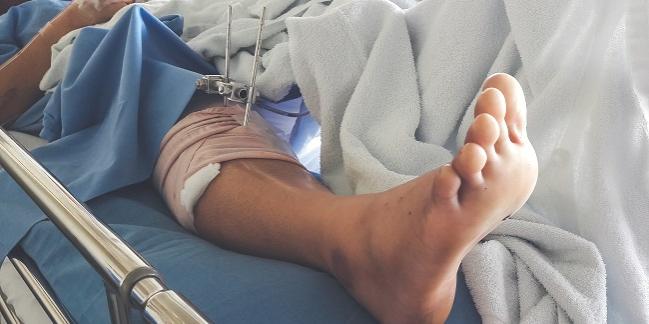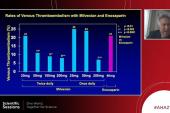PREVENT CLOT Supports Aspirin for VTE Prevention in Trauma Fractures
It’s unclear if aspirin can be considered for VTE prophylaxis after other types of surgeries and in high-risk nonsurgical patients, an expert notes.

Thromboembolism prophylaxis with aspirin is as effective as low-molecular-weight heparin in preventing mortality at 90 days in orthopedic trauma patients with fractures of an extremity, pelvis, or hip, according to a multicenter trial of more than 12,000 patients.
“Unlike arthroplasty, where aspirin is very accepted—at least in North America—aspirin is not very accepted in North America for trauma patients,” said Robert V. O’Toole, MD (University of Maryland School of Medicine, Baltimore), the study’s lead author.
While some data support aspirin alone as equivalent to heparin in preventing patients who have undergone total knee arthroplasty from developing venous thromboembolism (VTE), others like the recent Australian CRISTAL trial suggest it may not be enough prevention in knee or hip replacement patients.
O’Toole said the 12,000-patient PREVENT CLOT trial represents the largest attempt to understand if the simpler and cheaper alternative to heparin is justifiable in a nonelective fracture population treated with or without surgery.
At 90 days, there were 47 deaths in the aspirin group and 45 deaths in the low-molecular-weight-heparin group (P < 0.001 for a noninferiority). The risks of bleeding complications and pulmonary embolism (PE) were similar in both groups, but deep vein thrombosis (DVT) occurred more frequently in those on aspirin versus heparin (2.51% vs 1.71%). The difference was driven by clots below the knee, the same situation that was seen in the CRISTAL trial.
O’Toole said his group believes the results will likely influence prophylaxis recommendations for trauma patients both at the guideline level and in terms of individual centers’ policies.
“I think it’s good new data for us to have,” he added. “I suspect some hospital systems will switch their protocols and they'll save a lot of money if they do that. But, some might say that the small difference in blood clots in the leg is important to them [and] they might not switch.”
As Matthew Costa, PhD (University of Oxford, England), points out in an accompanying editorial, the below-the-knee DVT risk is something to consider, since some patients develop post-thrombotic syndrome that leads to chronic pain and swelling of their leg. However, Costa says he believes that guidelines for prevention of hospital-acquired VTE will need to be rewritten to include aspirin as an option in those with traumatic injuries based on the PREVENT CLOT results.
“More work is needed to determine whether aspirin should also be considered for venous thromboembolism prophylaxis after other types of surgeries and for nonsurgical patients who have risk factors for venous thromboembolism,” Costa notes.
‘Compelling Evidence’
Published today in the New England Journal of Medicine, PREVENT CLOT was conducted at 21 trauma centers in the United States and Canada. Patients with an arm or leg fracture anywhere from the hip to midfoot or the shoulder to the wrist were included, as were those with pelvic or acetabular fractures. Hospitalized patients (mean age 44.6 years; 62.3% men) were randomized to receive injectable enoxaparin 30 mg twice daily (n = 6,110) or oral aspirin 81 mg twice daily (n = 6,101).
Orthopedic trauma was the only known thromboembolic risk factor in 27.3% of the study population, and the mean duration of hospitalization was 5.3 days. Patients in the aspirin group received a mean of 8.6 doses while hospitalized and those in the heparin group received a mean of 9.1 inpatient doses, with a mean duration of 21 days prescribed at discharge in both groups.
I suspect some hospital systems will switch their protocols and they'll save a lot of money if they do that. Robert V. O’Toole
For the primary outcome of preventing death from any cause at 90 days, aspirin was noninferior to heparin (P < 0.001) but not superior (P = 0.63). The between-group difference in the 90-day probability of death being related to PE was similar to the difference in probability that it was not related to PE. Nonfatal PE occurred at a rate of 1.5% in both the aspirin and heparin groups, with most cases occurring within 7 days after randomization. Among those with distal or proximal DVT, the median time from randomization to occurrence was 16 days.
Bleeding events were seen in 13.72% of the aspirin group and 14.27% of the heparin group, with a median time to event of 2 days. Other adverse safety outcomes, including wound complications and deep surgical-site infections, were not different between the treatment groups.
According to Costa, the trial provides “compelling evidence that a readily available, inexpensive drug, taken orally, is a viable alternative to an injectable pharmacologic prophylaxis.”
With some evidence suggesting that weight and other measures of body size can influence the relationship between aspirin and clinical outcomes, O’Toole said a subanalysis is planned to look at that, as well as other characteristics that could put patients at a higher risk for thrombosis, including age and fracture type.
L.A. McKeown is a Senior Medical Journalist for TCTMD, the Section Editor of CV Team Forum, and Senior Medical…
Read Full BioSources
O’Toole RV, Stein DM, O’Hara NN, et al. Aspirin or low-molecular-weight heparin for thromboprophylaxis after a fracture: Major Extremity Trauma Research Consortium (METRC). N Engl J Med. 2023;388:203-213.
Costa M. Thromboprophylaxis after extremity fracture—time for aspirin? N Engl J Med. 2023;388:274-275.
Disclosures
- The study was funded by the Patient-Centered Outcomes Research Institute (PCORI).
- O'Toole reports consulting for Stryker and Zimmer.
- Costa reports no relevant conflicts of interest.





Comments